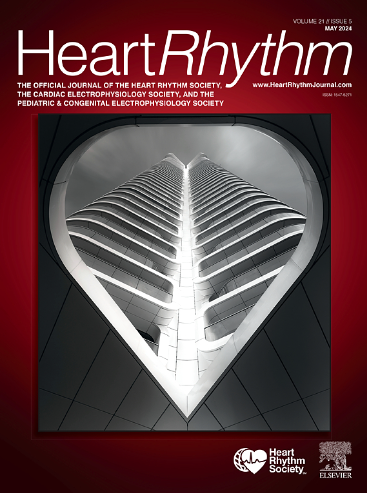Appropriate and inappropriate ICD shocks in patients with LVADs: Prevalence, associated factors, and etiologies
IF 5.6
2区 医学
Q1 CARDIAC & CARDIOVASCULAR SYSTEMS
引用次数: 0
Abstract
Background
Implantable cardioverter-defibrillator (ICD) shocks are a common complication after left ventricular assist device (LVAD) implantation; however, data on their frequency and causes are limited.
Objective
The purpose of this study was to define the incidence, programming, patient characteristics, and factors associated with appropriate and inappropriate ICD shocks in persons with LVADs.
Methods
We performed a retrospective review at Duke University Hospital of all LVAD recipients implanted between January 1, 2013, to June 30, 2019, with a preexisting ICD. ICD shocks were adjudicated by the treating physician and a second reviewer for the purpose of this study.
Results
Among 421 patients with an ICD in situ undergoing LVAD implant, 147 (33.9%) had at least 1 shock after LVAD implantation. Among 134 patients with complete device history, a total of 330 shock episodes occurred: 255 (77.3%) appropriate and 75 (22.7%) inappropriate. Etiologies for inappropriate shocks included supraventricular tachycardia (n = 66 [20.0%]), physiological oversensing (n = 1 [0.3%]), and nonphysiological oversensing (n = 8 [2.4%]) including LVAD electromagnetic interference (n = 1 [0.3%]). ICD programming with shorter detection delay (P <.001) and absence of antitachycardia pacing programming (P = .001) in high-rate zones was seen more commonly in inappropriate shock than appropriate shock.
Conclusions
The rate of inappropriate shocks in LVAD recipients is very high and most often is due to supraventricular arrhythmias. LVAD electromagnetic interference is a rare cause of ICD shock. Implementation of current consensus American Heart Association recommendations for LVAD programming with long detection delays and high rate cutoffs may help prevent inappropriate ICD shocks.
LVADS 患者中适当和不适当的 ICD 电击:发病率、相关因素和病因。
背景:植入式心律转复除颤器(ICD)电击是左心室辅助装置(LVAD)植入术后常见的并发症;然而,有关其发生频率和原因的数据却很有限:目的:确定左心室辅助装置患者 ICD 适当和不适当电击的发生率、程序、患者特征及相关因素:我们在杜克大学医院对 2013 年 1 月 1 日至 2019 年 6 月 30 日期间植入的所有 LVAD 受术者进行了回顾性审查,这些受术者均已植入 ICD。ICD 震荡由主治医生和本研究的第二位审查员裁定:在 421 名原位 ICD 患者中,有 147 名(33.9%)患者在植入 LVAD 后至少发生过一次电击。在134名有完整设备使用史的患者中,共发生了330次电击:255次(77.3%)合适,75次(22.7%)不合适。不适当电击的病因包括 SVT(n=66,20.0%)、生理超感(n=1,0.3%)和非生理超感(n=8,2.4%),包括 LVAD 电磁干扰(n=1,0.3%)。与适当电击相比,不适当电击更常见于检测延迟较短(p < 0.001)的 ICD 编程,以及在高速率区没有抗心动过速起搏编程(p = 0.001):结论:LVAD 受者的不适当电击率非常高,且多由室上性心律失常引起。LVAD 电磁干扰是 ICD 休克的罕见原因。在 LVAD 编程过程中实施当前 AHA 一致建议的长检测延迟和高频率截止值可能有助于避免不适当的 ICD 电击。
本文章由计算机程序翻译,如有差异,请以英文原文为准。
求助全文
约1分钟内获得全文
求助全文
来源期刊

Heart rhythm
医学-心血管系统
CiteScore
10.50
自引率
5.50%
发文量
1465
审稿时长
24 days
期刊介绍:
HeartRhythm, the official Journal of the Heart Rhythm Society and the Cardiac Electrophysiology Society, is a unique journal for fundamental discovery and clinical applicability.
HeartRhythm integrates the entire cardiac electrophysiology (EP) community from basic and clinical academic researchers, private practitioners, engineers, allied professionals, industry, and trainees, all of whom are vital and interdependent members of our EP community.
The Heart Rhythm Society is the international leader in science, education, and advocacy for cardiac arrhythmia professionals and patients, and the primary information resource on heart rhythm disorders. Its mission is to improve the care of patients by promoting research, education, and optimal health care policies and standards.
 求助内容:
求助内容: 应助结果提醒方式:
应助结果提醒方式:


